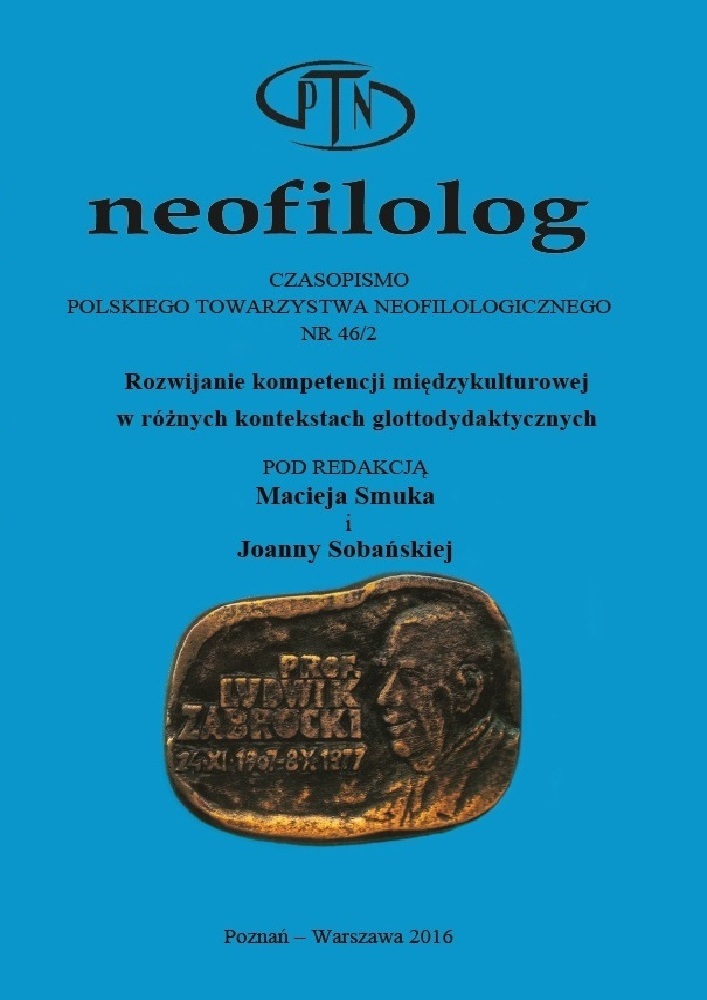Abstract
The paper discusses specific features of the Swedish sociocultural reality and the way the sociocultural diversity of the country is presented in language textbooks for Swedish language learners. The analysis is longi-tudinal in nature i.e. it concerns two editions of textbooks published in Sweden between 1996 and 2014. The presentation of Swedish sociocul-tural diversity is both explicit and implicit in nature, with changes in eth-nic diversity, household diversity, and family diversity being the most dy-namic ones. However, a number of differences between both textbooks are noticeable: in the older version information is presented mainly in an explicit form while its newer counterpart demonstrates the diversity of Swedish society both explicitly and implicitly.References
Byram, M. 1989. Cultural Studies in Foreign Language Education. Clevedon – Philadelphia: Multilingual Matters.
Byram, M. i M. Fleming. 1998. Language Learning in Intercultural Perspective. Cambridge: Cambridge University Press.
Byram, M., Nichols, A. i D. Stevens. 2001: „Introduction”. (w) Languages for Intercultural Communication and Education, 1: Developing Intercultural Competence in Practice. (red. M. Byram, A. Nichols i D. Stevens). Clevedon: Multilingual Matters Limited, str. 1-8.
Domeji, R. 2010. „Elektronisk kommunikation – möjligheter och svårigheter”. Wykład wygłoszony podczas konferencji ASLA. Språk för framtiden. Falun, 12-13 listopada 2010.
Encyklopedia PWN. [online: http://encyklopedia.pwn.pl/haslo/kultura;3928887.html; DW 8.01.2016].
Główny Urząd Statystyczny. 2015. [online: http://stat.gov.pl/obszary-tematyczne/ludnosc/ ludnosc/ludnosc-stan-i-struktura-ludnosci-oraz-ruch-naturalny-w-przekroju-ter ytorialnym-stan-w-dniu-31-xii-2014-r-,6,17.html; DW 8.01.2016].
Migrationsverket. 2016. [online: http://migrationsverket.se; DW 8.01.2016].
Parkvall, M. 2009. Sveriges språk. Vem talar vad och var? RAPPLING 1. Rapportert från institutionen för lingvistik. Stockholms universitet.
Słownik języka polskiego. [online: http://sjp.pwn.pl/sjp/kultura;2565197.html; DW 8.01.2016].
Statistik för alla 2015/2016. 2015. Örebro: Statistiska Centralbyrån. [online: http://scb.se; DW 8.01.2016].
Tomlinson, B. 2000. „Materials for cultural awareness: combining language, literature and culture in the mind”. The Language Teacher, 24(2): 19-21.
Tronsoco, C. R. 2010: „The effects of Language Materials on the Development of Intercultural Competence”. (w) Research for Materials Development in Language Learning: Evidence for Best Practice. (red. B. Tomlinson i H. Masuhara). London: GBR: Continuum International Publishing, str. 83-102.
Wielki słownik języka polskiego. [online: http://wsjp.pl/index.php?id_hasla=3479&ind= 0&w_szukaj=kultura; DW 8.01.2016].
License
Copyright (c) 2018 Iwona Kowal

This work is licensed under a Creative Commons Attribution-NoDerivatives 4.0 International License.
Authors
Authors of texts accepted for publication in Neofilolog are required to complete, sign and return to the Editorial team’s office the Agreement for granting a royalty-free license to works with a commitment to grant a CC sub-license.
Under the agreement, the authors of the texts published in Neofilolog grant Adam Mickiewicz University in Poznań a non-exclusive, royalty-free license and authorize the use of Attribution-NoDerivatives 4.0 International (CC BY-ND 4.0) Creative Commons sub-license.
The authors retain the right to the free disposal of the work.
Users
Interested Internet users are entitled to use works that have been published in Neofilolog since 2017, under the following conditions:
▪ attribution – obligation to provide, together with the distributed work, information about the authorship, title, source (link to the original work, DOI) and the license itself.
▪ no derivatives – the work must be preserved in its original form. Without the author's consent, it is not possible to distribute the modified work in the form of translations, publications, etc.
Copyrights are reserved for all texts published since 2017.
Miscellaneous
Adam Mickiewicz University in Poznań retains the property right as a whole (layout, graphic form, title, cover design, logo etc.).
